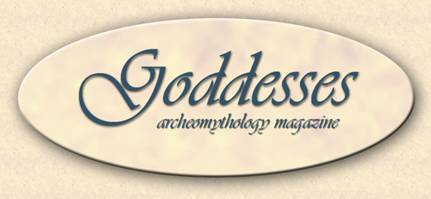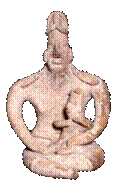Abnoba A Romano-Celtic goddess who presided over forests and rivers. Her worship is believed
to have originated in Germany's Black Forest religion. The name "Avon" (which has been given to
numberous rivers throughout Europe) derives from Abnoba's name.
Abundantia A Roman goddess of fertility and the personification of abundance. According to mythology,
Abundantia is a lady who enters houses in the middle of the night when all inside are sleeping, and
brings prosperity.
Aditi An Archaic Hindu mother goddess who was believed by some to take on the appearence of a cow.
She was also a guardian goddess, the bringer of prosperity, and thye remover of obstacles.
Ahurani A Persian (Zoroastrian) goddess of fertility who was also the mistress of Ahura Mazda, the god of light. She was often invoked by those seeking prosperity and women who wished to have children. Water libations were an important aspect of the rituals associated with her.
Aje A goddess of wealth who was worshipped throughout Nigeria. In the creation myth associated with her, Aje was sent down to Earth, along with the creator goddess Oduduwa, It was believed by her followers that she appeared to humans in the form of a fowl scratching the dirt.
Akonadi A Ghanaian oracular goddess who was worshipped by many Weat Africans. In Accra, she had a celebrated oracular shrine. Akonadi is also a deity associated with justice and the protection of women.
Ala A Nigerian goddess of fertility. She also rules the Underworld, and it is believed that the souls of the dead rest within her sacred womb. Thr cresent moon is her symbol and she is often depicted in works of art as a seated woman holding a small child in her arms. Each year her followers pay homage to her with an event known as the Yam Festival.
Alcyone A Greek goddess who was changed into a kingfisher by the gods after she threw herself into the sea upon finding the body of her drowned husband Ceyx washed up on the shore. The seven days preceding the Winter Solstice and the seven days afterit are know as the Halcyon Days, named after Alcyone. It was during this time, according to ancient Greek mythology, that Alcyone kept the waters peaceful and calm so that she could build her nest upon the surface of the sea and sit on it until her eggs hatched.
Alpan Also known as Apanu, she was the Etruscan goddess of the art of sexual love, as well as a deity who ruled over the Underworld. In works of art, she is depicted as a winged woman clad in nothing more than a loose cloak, sandals, and jewels.
Anatum Sumerian goddess of creativity, creation.
Aphrodite Aphrodite is the greek goddess of sexual love. She was born of the bloody foam of the sea where Cronus threw the genitals of his father Uranus after castrating him. She was in fact an ancient East Mediterranean goddess and is associated with Astarte.
Astarte Astarte in ancient Phoenicia is the great goddess of fertility, motherhood and war. She is the counterpart to the Babylonian goddess Ishatar and is one of the oldest middle Eastern aspects of the goddess, dating to the Neolithic and Bronze ages
Athena
Athena is the Greek goddess of intelligence and the arts and peace, she is also a warrior goddess. Athena is protector of all towns above all of Athens.
Bast
Bast is the Egyptian cat goddess of Bubastis in Delta. Originally lion-headed, she represents the benficient power of the sun.
Brighid (Brigid, Brigit, Brid)
Brighid is the Irish goddess of fertility and inspiration. Her characteristics, legends and holy places were taken over by the historical St. Bridget.
Callisto
Callisto is a Greek moon goddess. She is linked with Artemis, and is often called Artemis.
Cerridwen (Kerridwen)
Cerridwen is the Celtic goddess of wisdom, intelligence, magick, divination and enchantment. She possessed the gifts of prophecy and shape-shifting and presided over the mysteries of the Druidic bards. She is also associated with water and the moon, which represents the emotions, the unconsious and intuition. Her primary symbol is the cauldron.
Circe
In Greek mythology, Circe is a sorceress renowned for her enchantments. Described by Homer as fair haired, she was sometimes said to be the daughter of Hecate, the patron goddess of witchcraft and magick. It has been said that she controlled fate and the forces of creation and destruction with the braids in her hair. She is seen both as a moon goddess and as a goddess of degrading love.
Dana (Danu)
Danu in Irish mythology is the mother goddess of the Fairies, the divine race of old Irish myth. In some legends she was the daughter of Dagda, the solar god.
Demeter
Demeter is the Greek goddess of the fertile soil and agriculture, who is an important aspect of the goddess deity worshipped in contemporary witchcraft. As a goddess of nature, Demeter also represents women, marriage, harmony and health. She controls the seasons, the dying of the earth in winter and its rebirth in spring. She is acknowledged in the spring and autumn equinox sabbats, just as she was worshipped in ancient times.
Diana (Artemis)
Diana is the classical goddess of the moon and the hunt. Diana has been considered on of the most important aspects of the goddess in modern witchcraft. Diana is the counterpart to the Greek goddess Artemis and personifies the positive attributes of the moon. She is a virgin goddess and a maiden warrior. She is the eternal feminist, owned by no man and beholden to none. As a moon goddess, Diana shares the lunar trinity with Selene and Hecate.
Epona Celtic horse goddess. Her giant likeness has been found dug from the earth of a hillside in England, the removed earth was replaced with white limestone.
Ereshkigal Sumerian Queen of the Underworld, which she was granted at the dawn of creation. (Also see: Inanna and Anatam)
Fortuna
Fortuna is the Roman goddess of fortune, fate, blessing, luck and fertility.
Freya (Freyja)
In Norse mythology, Freya is a blue-eyed, blonde hair goddess of love, procreation and fecundity. The hare is her companion and she was the wife of Odur, the god of sunshine. Freya is often confused with Frigga the wife of Odin and the goddess of marital love and marriage.
Gaia (Gaea)
In Greek mythology, Gaia is the mother earth goddess. Gaia or the "Deep-Breasted One", is the oldest of deities. Gaia corresponds to all other earth mother deities in other cultures, who have been known as the great goddess, the white goddess and mother nature.
Hathor
Hathor is an ancient Egyptian sky goddess. She is the goddess of pleasure, joy, love, music and dancing. A protectress of women and embodiment of the finest female qualities.
Hecate
Hecate in Greek mythology is a powerful goddess who has evolved into the patron goddess of Witchcraft and magick. Hecate has three aspects: godess of fertility and plenty; goddess of the moon; and Queen of the night, ghosts and shades. In her moon-goddess aspect, she is often part of a trinity with Selene and Diana/Artemis - the triple goddess.
Hera
Hera was the Queen of the Olympian deities. She is the eldest daughter of Cronus and Rhea. Hera is mainly worshipped as a goddess of marriage and birth. It is said that each year Hera's virginity returns by bathing in the we Canathus. The peacock and the cow are her sacred animals and she is portrayed as a mejestic solemn women. Her Roman counterpart is Juno.
Hestia
Hestia is the Greek goddess of the hearth fire, hence presiding over all domestic life. She is a virgin goddess and the gentlest of all Olympians. The Romans called her Vesta, and built a temple for her in the forum.
Holda (Holde, Hulda)
Holda is a fierce Germanic goddess of the sky, whose nocturnal rides with the souls of the unbaptised dead led to the Christian association of her with the demonic aspects of the wild hunt. Holda is beautiful and stately. She is also a goddess of the hearth and motherhood.
Inanna
Inanna is a Sumerian mother goddess, Queen of Heaven, ruler of the cycles of the seasons and fertility. She was also called Nina, the goddess name Inanna may be a derivative of Nina. She was the mose widely known goddess in the later periods of Sumer.
Ishtar
Ishtar is the Greek mother goddess of ancient Assyrian and Babylonian mythology. Either the daughter of the sky god Anu, or the moon god Sin. Over the course of time, Ishtar absorbed the characteristics of other goddesses and so she can represent differect aspects. She ruled over fertility, sex, war and protected man against evil.
Isis
Isis is the ancient Egyptian mother goddess, the prototype of the faithful wife and fertile, protective mother. She is associated with Sirrius, the dog star, the rising of which signals the Vernal equinox. Her symbol is the moon.
Kali
Kali is the Hindu goddess of death, destruction, fear and terror, and is the wife-consort of Siva, the destroyer.
Kuan Yin
Kuan Yin is the Chinese goddess of mercy and a protector of women. She is known as "The Lady who Brings Children" and is the most universally respecterd and popular Chinese deities and is a favorite among many feminist neo-pagans and witches.
Matsu
Protector of Chinese fishermen. She has an island named after her in the Taiwan straight. The pair of islands are called Kamoi and Matsu, often the focus of naval jousting between Japan and China.
Persephone
In Greek mythology, Persephone is the goddess of the underworld. She is the daughter or Zeus and Demeter, and is a goddess of the harvest. The Romans called Persephone. She’s also known as Kore.
Rhea
Rhea, in Greek mythology is the mother of the gods. She is identified with the mother goddess Cybele from Asia Minor, and is also known as Rhea Cybele and the Great Mother. She was worshipped with orgiastic rites. Rhea is depicted between two lions or on a chariot pulled by lions.
Selene
Selene is the Greek goddess of the moon, she is a winged, silvery woman, who presides over
the night skies, sailing along in her chariot pulled by shining, winged white horses, cows or bulls.
Selene is one aspect of the triple goddess, along with Diana/Artemis and Hecate. Selene is
worshipped at new and full moons, and she influences the female force in all life forms on earth.
Venus
Venus was originally the goddess of spring and protectress of vegetation and gardens.
She was a minor deity until she became assimilated to the Greek Aphrodite in the
second century BC
Please email us your contributions.


















